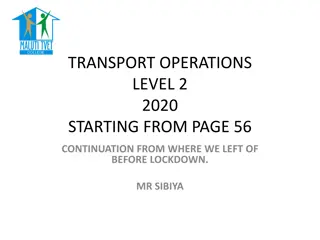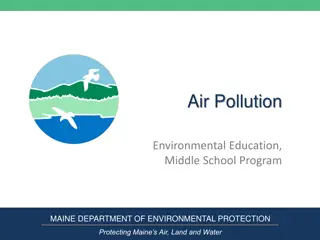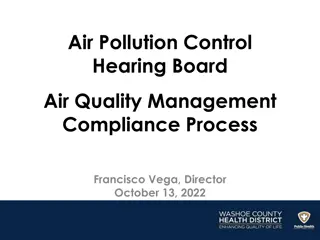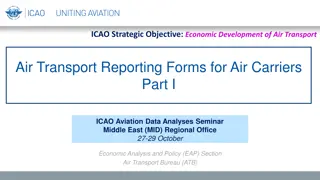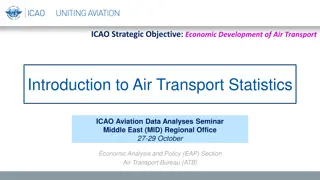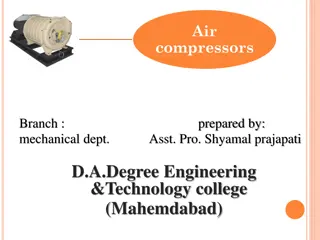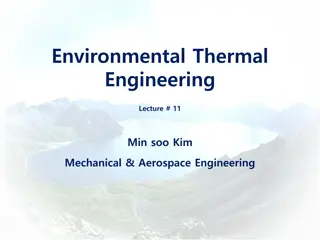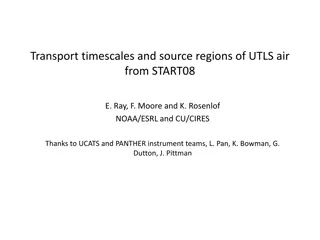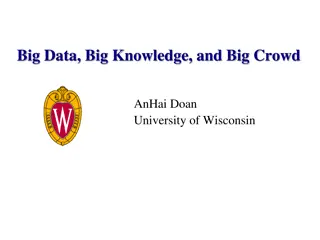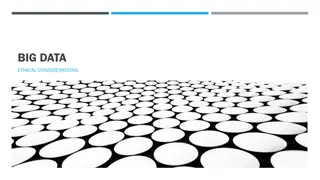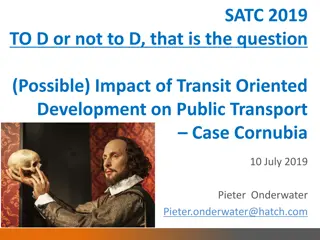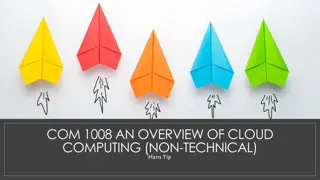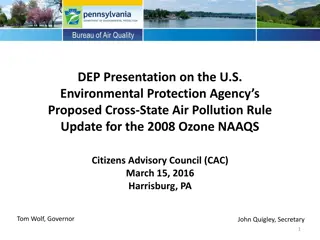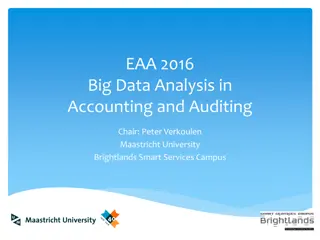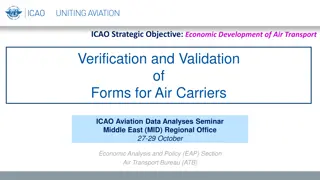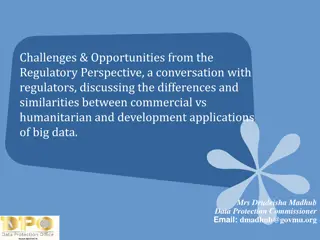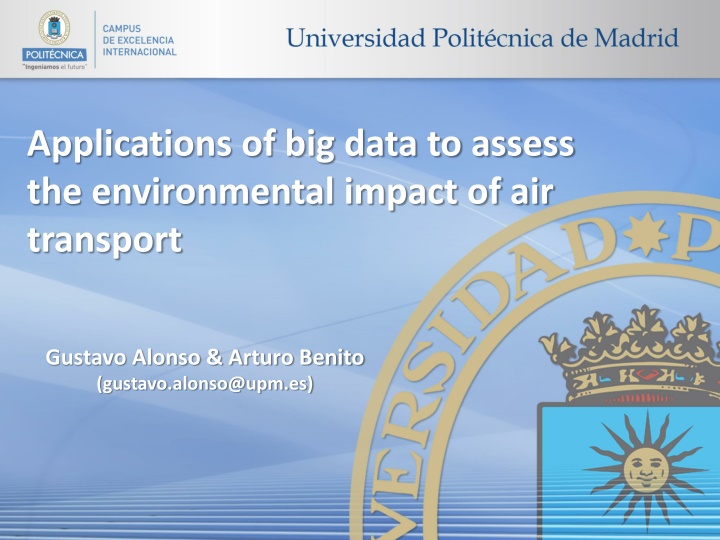
Applications of Big Data in Assessing Air Transport Environmental Impact
"Explore the use of big data in evaluating the environmental impact of air transport, including global emissions and local effects like airport air quality and noise. Learn about the innovative Cassiopeia project applying Complex Systems Science to optimize Air Traffic Management efficiency. Discover how data science can address environmental challenges in aviation R&D." (299 characters)
Download Presentation

Please find below an Image/Link to download the presentation.
The content on the website is provided AS IS for your information and personal use only. It may not be sold, licensed, or shared on other websites without obtaining consent from the author. If you encounter any issues during the download, it is possible that the publisher has removed the file from their server.
You are allowed to download the files provided on this website for personal or commercial use, subject to the condition that they are used lawfully. All files are the property of their respective owners.
The content on the website is provided AS IS for your information and personal use only. It may not be sold, licensed, or shared on other websites without obtaining consent from the author.
E N D
Presentation Transcript
Applications of big data to assess the environmental impact of air transport Gustavo Alonso & Arturo Benito (gustavo.alonso@upm.es)
Applications of big data to assess the environmental impact of air transport CONTENTS Introduction The Cassiopeia project Other application examples DIAPOSITIVA1
Introduction Future air transport growth is only possible if it can be made compatible with the restrictions needed to protect the environment from excessive anthropogenic interference. The environmental impact of air transport has a global effect related to the emissions of green-house gases along the whole flight and a local effect linked to the quality of the air around the airport and to the noise inflicted in that area. Data Science can help understanding and addressing this issue. Some examples from the Air Transport R&D Group at the Technical University of Madrid (UPM) in cooperation with Innaxis Research Institute are presented. DIAPOSITIVA2
Applications of big data to assess the environmental impact of air transport CONTENTS Introduction The Cassiopeia project Other application examples DIAPOSITIVA3
THE CASSIOPEIA PROJECT CASSIOPEIA (Complex Adaptive Systems for Optimisation of Performance in ATM) Funded by EUROCONTROL under the SESAR programme (Single European Sky ATM Research). Consortium members: Innaxis Research Institute, Technical University of Madrid (Department Artificial Intelligence and Department of Air Transport) and University of Westminster (Department of Transport Studies). Project Coordinator: Innaxis Research Institute DIAPOSITIVA4
THE CASSIOPEIA PROJECT The Project applies Complex Systems Science as an innovative approach to model and measure the efficiency of ATM, including all the stakeholders interests by using Agent Based Modelling. DIAPOSITIVA5
THE CASSIOPEIA PROJECT The tool is applied to different Case studies with environmental implications (noise night curfew at airports), business implications (ATFM slot allocations as a tradeable commodity), etc. All Case studies take as a starting point actual data which is then used to feed the simulation tool. Case Study 1 is designed with the purpose of simulating the different stakeholders response to the potential implementation of curfews in the 10 largest (by number of passengers) European Union airports, following the stream of Frankfurt-Main, where the opening of an additional runway was traded off with a night curfew. DIAPOSITIVA6
THE CASSIOPEIA PROJECT: Case Study 1 The list of flights and their arrival/departure local time out of each airport is taken from EUROCONTROL PRISME database. For this specific simulation the central week of June has been selected as representative average week traffic for the year. Based on the actual flight plans data, simulations are performed based on potential decisions taken by the different stakeholders, and new flight plans are generated. DIAPOSITIVA7
THE CASSIOPEIA PROJECT: Case Study 1 regulators local authorities pressure groups airport establishes environmental regulation airlines divert flight to other airports airlines suffer increase in costs airlines demand more efficient and less noisy aircraft to manufacturers airlines re-schedule flights airports without restrictions may gain traffic ATC finds increased saturation at certain hours of the day airports with restrictions may loose traffic overall airlines increase fares more costs to airlines? future problems in airports without restrictions? less traffic? pressure groups local regulators authorities DIAPOSITIVA8
THE CASSIOPEIA PROJECT: Case Study 1 After the airport curfew decision, the airlines having flights in the regulated periods may choose one of the following actions: keep the flight moving the scheduled time out of the restricted period o maintain the schedule but using an alternative airport o cancel the flight o The decision will be influenced by the type of the company, its relation with the airport, the distance to the alternative airport and the time interval between the original and the new schedule. Based on those decisions the tool generates a new routes network and scheduling by modifying the actual one (taken from PRISME database). DIAPOSITIVA9
THE CASSIOPEIA PROJECT: Case Study 1 The results of the schedule changes are quantified in terms of a series of indicators, reflecting the variations in airline turnover, airport turnover, airport region economic losses due to lower traffic, jobs reduction due to lower traffic, average movements per hour, cumulative noise load ratio per hour, NOx emissions ratio per year and CO emissions ratio per year. DIAPOSITIVA10
Applications of big data to assess the environmental impact of air transport CONTENTS Introduction The Cassiopeia project Other application examples DIAPOSITIVA11
AIR TRANSPORT EMISSIONS INVENTORY MODELLING Example 2: MECETA (Spanish Model for the Calculation of Air Transport Emissions), for the Spanish government. Developed in 2010. MECETA Example 3: CO2 emissions inventory in the European airspace in 2004-2005-2006 for EUROCONTROL (project to establish the baseline for the European Emissions Trading Scheme), in cooperation with Innaxis DIAPOSITIVA12
AIR TRANSPORT EMISSIONS INVENTORY MODELLING The calculation of air transport emissions inventory is a need (ETS, CORSIA) and requires a certain level of modelling. The most basic approach is using the instructions of the CORINAIR program (many countries are using this procedure to obtain an aggregated figure with a modest accuracy level). The calculation can be substantially improved by using available actual data: MECETA. DIAPOSITIVA13
AIR TRANSPORT EMISSIONS INVENTORY MODELLING MECETA takes actual data from airlines and the airport where they operate (taxi times, aircraft types and weights, take-off and landing procedures, fuel consumption, etc., to correct and calibrate CORINAIR database. Based on the updated information, more accurate projections can be made on future emissions to prepare National Action Plans requested by ICAO. DIAPOSITIVA14
AIR TRANSPORT EMISSIONS INVENTORY MODELLING Further improvements are being investigated, in order to reduce the calculations uncertainty in different areas, as database exploitation, more precise identification of the airframe-engine combinations of the studied fleet, better characterisation of the LTO cycle features, adapting them to specific airports and routes to be operated and corrections of the rest of the flight performances to bring them closer to the actual operation. DATA SCIENCE IS ESSENTIAL DIAPOSITIVA15
CO2 EMISSIONS EVOLUTION, ANALYSIS AND PROJECTION Example 4: Study on airborne transport activity and fuel/energy demand, for the European Commission (Joint Research Centre). o Investigations on the distribution of air transport traffic and CO2 emissions within the European Union. o Analysis of the recent evolution of commercial air traffic CO2 emissions and fleet utilization in the European Union. Example 5: Development of a model to analyse the viability of the large scale utilization of biofuels in future scenarios of the European Union aviation (ITAKA project, funded by EU) DIAPOSITIVA16
CO2 EMISSIONS EVOLUTION, ANALYSIS AND PROJECTION In all these projects actual flight data is taken from EUROCONTROL DDR (Data Demand Repository) where all flight plans are stored. Actual traffic data is taken from EUROSTAT database. Aircraft fuel consumption is taken from CORINAIR (corrected). Then it is posible to calculate representative parameters, like the evolution of the efficiency parameter in terms of CO2 / RPK, analyse its evolution along the last years and make different scenarios for future projections. DIAPOSITIVA17
LOCAL IMPACTS: NOISE & EMISSIONS Example 6: local impacts analysis o The efficiency of noise abatement operating restrictions o The efficiency of noise mitigation measures at European airports o An analysis of the effectiveness of airport charges to reduce NOx emissions Again, the method uses actual data (EUROCONTROL DDR, airports flights databases, etc.) to analyze the evolution of a given parameter (noise or NOx per passenger) and make projections. DIAPOSITIVA18
CONCLUSIONS Environmental impact is a concern for the sustainability of air transport. This industry keeps huge records of flight data. Data Science can help understanding and analysing the implications, as well as implementing mitigation measures. Some exmples have been shown to illustrate it. DIAPOSITIVA19
CONTACT Arturo Benito arturo.benito@upm.es Gustavo Alonso gustavo.alonso@upm.es ETSI Aeron utica y del Espacio Universidad Polit cnica de Madrid Pza. Cardenal Cisneros 3 E-28040 Madrid Tel. +34 91 33 66 316 DIAPOSITIVA20
SOME RECENT REFERENCES Alonso, G., Benito, A., Lonza, L., Kousoulidou, M., Investigations on the distribution of air transport traffic and CO2 emissions within the European Union. Journal of Air Transport Management, Vol. 36 (2014) pp 85-93. Aminzadeh, F., Alonso, G., Morales, G., Benito, A., Analysis of the recent evolution of commercial air traffic CO2 emissions and fleet utilization in the six largest national markets of the European Union. Journal of Air Transport Management, Vol 55 (2016) pp. 9-19. Mohd Noh, H., Benito, A., Alonso, G., Study of the current incentive rules and mechanisms to promote biofuel use in the EU and their possible application to the civil aviation sector. Transportation Research Part D: Transport and Environment, Vol 46 (2016), pp.298-316. Alonso, G., Benito, A., The efficiency of noise abatement operating restrictions, Congreso de Ingener a del Transporte, Santander, Spain, June 2104 Benito, A., Alonso, G., Commercial aircraft energetic efficiency evaluation, Congreso Panamericano de Ingenier a del Transporte, Santander, Spain, June 2014 Alonso, G., Benito, A., Boto, L., The efficiency of noise mitigation measures at European airports, World Conference on Transport Research - WCTR 2016 Shanghai, July 2016 Alonso, G., Benito , An analysis of the effectiveness of aiport charges to reduce NOx emissions, Air Transport Research Society Congress ATRS 2017 Antwerp, July 2017 DIAPOSITIVA21


